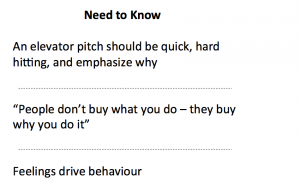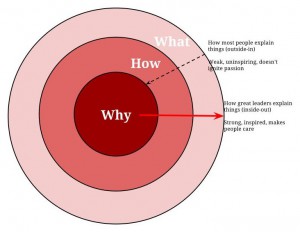Are You Putting Your Best Foot Forward First? Rapport: Part Three
October 25, 2015 ~ Written by: W.B. “Bud” Kirchner
“It usually takes me more than three weeks to prepare a good impromptu speech.” ~ Mark Twain
Over the years I have spent a lot of time struggling with how to introduce Kirchner Group to people. The considerable breadth and depth, as reflected in the diversity of our platform (especially for a boutique), was often seen as a disadvantage as much as an advantage – thus the challenge.
To put this in a real world (business) context, this type of challenge (vis-à-vis ‘telling your story’) results in delayed revenue from clients and delayed deals with partners! Instead of paying you to help them succeed, they are still trying to extract from your story the parts that can help them. Then I came upon the work of Simon Sinek and his TEDTalk on the Golden Circle. That is when it dawned on me – I (like many business founders) had it backwards (if only this was the lone time I have had it backwards!)
Why do You do What You do?
 I was determined to brag on the fact we were advisors working on helping companies grow and develop, blah, blah, blah. Rehabilitating companies that had lost their way, blah, blah, blah. Business process improvement, conducting mergers and acquisitions, blah blah blah. Then I would move to the large amount of assets we managed, blah blah blah. Then if anyone was still awake I would move on to how we do this, blah blah blah. A large team of senior only professionals with vast domain and process experience, blah blah blah. It was annoying (as a friend said – it reminded him of a “Beavis and Butthead” routine) and it was costing me business!
I was determined to brag on the fact we were advisors working on helping companies grow and develop, blah, blah, blah. Rehabilitating companies that had lost their way, blah, blah, blah. Business process improvement, conducting mergers and acquisitions, blah blah blah. Then I would move to the large amount of assets we managed, blah blah blah. Then if anyone was still awake I would move on to how we do this, blah blah blah. A large team of senior only professionals with vast domain and process experience, blah blah blah. It was annoying (as a friend said – it reminded him of a “Beavis and Butthead” routine) and it was costing me business!
In retrospect, my challenge (error) was that I would lead with the “what we are” and the “how we did things” – particularly because I was so proud of both. In our case, the relegation of “why” to later in the discussion is particularly ironic since our group was formed with a strong culture that centered around our cause (belief) for being: creating value in businesses from multiple perspectives and scales.
You’ve heard of the elevator pitch? Well I have an ‘elevator door is shutting pitch’ – and it goes like this:
“We believe that every business and every portfolio of business can be made more valuable and that none should become valueless.”
Quick. Hard hitting. You want them to stop the elevator. You want them to invite you in. Make them invite you in with one strong sentence that defines your reason – your purpose – for why you exist. One strong sentence that shows why they need you.
One might reasonably think that as you grow, and in our case diversify, “why” would not be enough. As time has advanced (we are now more than 30 years’ old) the “why” aspect is actually what has held us together and the glue that enables us to add more and more facets in terms of how we create value. So – (finally!) I am proud and rewarded to be leading with “why.” Once we have the emotional link of “why” – I (and my partners) are anxious to discuss the “what” and “how.”
Now our message is simpler but resonates more. And Spoiler Alert – not to preempt Sinek’s story and his punchline, but I agree:
“People don’t buy what you do – they buy why you do it.”
The fact that we were in business for over two decades until we understood the best way to introduce ourselves is what I’m trying to save you from. Our Business Brain Model℠. is being presented to keep you from making so many of the mistakes I have made – this is my value proposition.
Back to what Simon Says
His model reflects a couple important tenets:
- It is biology not psychology that determines ‘sales’.
- Feelings drive behavior.
The approach of Sinek fits our model context and theme perfectly. The key backdrop is how one makes decisions as it relates to different part of the brain:
- Neocortex → What – Feelings/trust not language
- Limbic → How – (Rationale and language)
- Limbic → Why – trust – decision
This can be summarized in what he calls the “Golden Circle” which coincides with how the brain works (is structured).
Why
- Purpose
- Cause
How
- Value proposition
- Protocols
What
- The thing you do
- The thing you are
Based on our original theme of communication – it should go from inside → out.
For the skeptics in the crowd be sure to watch (in the same Sinek Ted Talk):
- The Wright brothers story about Blood vs. Money (starts at 8:15 in the video)
- The Law of Diffusion of Innovation Example (starts at 11:08 in the video)
“…at their first appearance innovators have generally been persecuted, and always derided as fools and madmen.” ~ Aldous Huxley
The logic (and evidence) behind Sinek’s “Golden Circle” is compelling and dovetails with so many of the principles of our Business Brain Model. So once again, I ask you the question you need to ask yourself: why do you do what you do?
About the Author: W.B. “Bud” Kirchner is a serial entrepreneur and philanthropist with more than 50 years of business success. He is not a scientist or an academic but he does have a diversified exposure to neuroscience, psychology and related cognitive sciences. Generally speaking, the ideas he expresses here are business-angled expansions of other people’s ideas, so when possible, he will link to the original reference.


